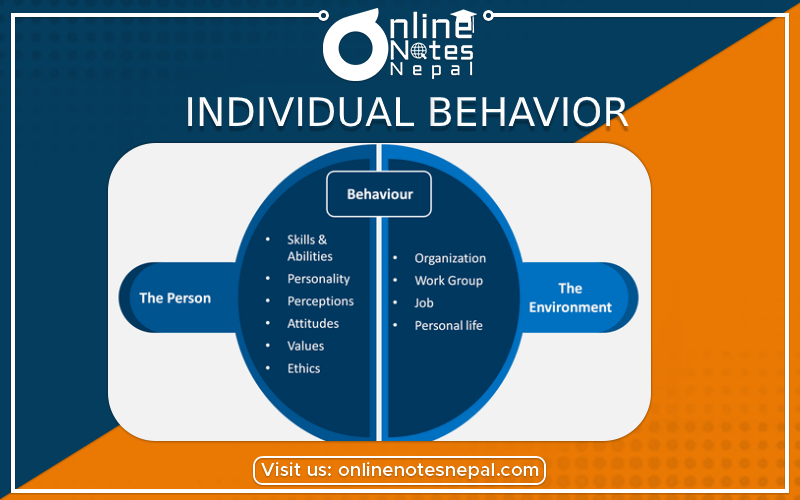Published by: Sujan
Published date: 14 Jun 2021

Concept: Individual behavior is caused, motivated, and goal-oriented. Every individual is different from their birth even in twins closer observation may be needed but, we can find distinct and unique instincts, reflexes, and personal abilities. To understand the root problem of the organization, a thorough study of individual behavior plays a vital role.
Soon after birth, a person is affected by environmental variables. The inherited characteristics are converted into a learning experience to a complete personality. Heredity and environment are so closely linked together that it is impossible to isolate the effect of one on anyone another in developing and molding individuals. It is a long search of a man in quest of finding himself.
Psychologist Kurt Lewin has conducted considerable research into human belief and proved that behavior is affected by the number of both genetic and environmental factors.
B=f(P,E)
where B=individual behavior
P=Person
E= Environment around him
The table shows what includes in the person and the environment in the context of human behavior:
The person |
The environment |
| 1. Personal factors:
a. Sex b. Age c. Education d. Abilities e. Marital status |
1. Environment factors:
a. Economic conditions b. political situations c. Cultural values, and d. Social norms |
| 2. Psychological factors
a. Personality b. Perception c. Attitudes d. Values, and e. Learning. |
2. Organizational factors
a. Physical facilities b. Organizational structure c. Organizational design d. Leadership styles, and e. Reward system. |
DETERMINANTS OF INDIVIDUAL BEHAVIOR:
Goals:
All individuals are goal-oriented and they pay their physical and mental efforts to get the specified goal. Goal setting clarifies the intentions of the individual to achieve the goal which obviously shapes our actions.
| Why do we need to study individual goals? |
| Goals are ultimate objectives that employees want to achieve with their efforts. |
| they are useful to provide useful tools to manage motivation and to use them as a controlling mechanism for managing work in the organization |
| It helps to focus employees’ attention on items of greater importance and stimulates them towards goal attachment. |
| managers should set goals for an organization as well as for an individual employee. |
2. Beliefs
What are beliefs?
Beliefs are cognitions, or thoughts, about the characteristics of objects. Attitudes are a result of beliefs.
| Why do we need to study beliefs? |
| Beliefs provide continuity to the personality of an individual. |
| It assigns meanings to an individual’s day-to-day perceptions and activities and serves in his attempted solutions. |
| How are beliefs formed? |
| Experience |
| Available information |
| Generalizations |
3. Attitudes
Shakespeare opines “one might smile and smile and yet be a villain” it is not simply a cause of double living as well.
It refers to the way a person feels about and disposed towards some ‘object’. The object could be a physical object or a set of objects (e.g., what’s your attitude towards politics in Nepal?, a specific person (e.g. what’s your thoughts on entrepreneurship in our country?).
| Features of Attitudes |
| Attitude is the predisposition of an individual to evaluate some object favorably or unfavorably. |
| The most persuasive phenomenon is ‘attitude’. People at the workplace have attitudes about lots of topics that are related to them. |
| It is a mental state of readiness to be motivated. It is neither behavior nor a cause of the behavior. |
| It can also vary about the needs they serve. |
Types of Job-related attitudes:
Attitude formation: